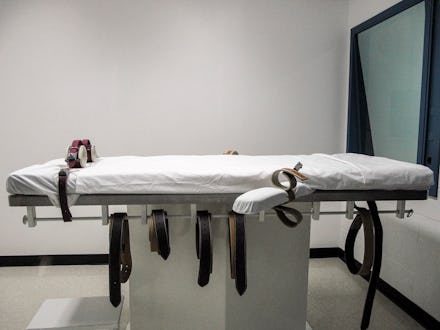The Death Penalty Rate in the US Is on the Decline — Here's Why

The topic of capital punishment hasn't surfaced much in this year's presidential debates, perhaps because national security, gun control, climate change and terrorism seem more urgent — or perhaps it's simply because the death penalty is on the decline. The Death Penalty Information Center (DPIC) released its annual, year-end report on Wednesday, the title of which says it all: "Death Penalty Use in 2015 Declines Sharply: Fewest Executions, Fewest Death Sentences and Fewest States Employing the Death Penalty in Decades."
In 2015, there were 28 executions in six states, a 20% drop from 2014, according to the report. There were 49 death sentences dealt nationwide, a 33% decrease from 2014's record low. Fewer sentences have been handed out in the past decade than in the 10 years before 1972, when the Supreme Court invalidated capital punishment. 2015 also saw six death-row inmates — total population of which dropped below 3,000 "for the first time in a generation" — cleared of all charges, reports the DPIC.
Why the falling numbers? This year's report states that 93% of of executions occurred in four states: Florida, Georgia, Missouri and Texas. Texas — which executed 13 inmates this year — is infamously the capital punishment stronghold of the U.S., having executed 531 prisoners since 1982. Nationwide, use of the death penalty peaked in 1999 with 98 executions. That was also a peak year for Texas, with 48 of the 460 people on death row executed. The DPIC cites the state's 2005 "adoption of the alternative sentence of life without parole" and "a change in the political climate" among the reasons for this year's lower execution rates.
Both reasons are valid: this year's DPIC report says, according to public opinion polls, that "a majority of Americans preferred life without parole to the death penalty" and that a "national trend toward abolition of the death penalty in law or practice continued" in Nebraska, Connecticut and Pennsylvania.
But there's another factor worth examining: Texas uses lethal injection to execute inmates, and nationwide, 2015 was not a good year for lethal injection.
Botched lethal injections: Last year brought the issue of botched executions using lethal injection to the nation's attention. Three cases — those of Dennis McGuire, Clayton Lockett and Joseph Wood — highlighted a problem with the drug cocktail typically used in this version of capital punishment: the drugs are neither swift nor painless, which became clear to witnesses who, according to the DCIP, watched the three men continue to gasp and struggle for 25, 43 and 100 minutes, respectively. In Oct. 2015, Oklahoma used the wrong drug in an execution. Instead of stopping inmate Fredrick Warner's heart, the injection essentially embalmed him alive.
Components of the lethal injection cocktail include a chemical that paralyzes the body and a chemical that stops the heart, and sometimes an additional anesthetic chemical. NPR reports that the drugs are difficult to procure, because pharmaceutical companies would prefer to avoid association with capital punishment. This has prompted "states to seek new formulas using untested doses and find new compounding pharmacies to make their execution drugs," which means that they're purchasing altered forms of brand-name drugs from not-necessarily-accredited sources. As of 2013, Texas is among the states that using drugs from compounding pharmacies.
Midazolam has been substituted into the lethal injection cocktail as the anesthetic. Midazolam, however, is a sedative; it doesn't prevent prisoners from feeling pain. On June 29, the Supreme Court upheld the use of midazolam on the grounds that the trial hadn't proven that a less painful method exists, reasoning that dissenting Justice Sonia Sotomayor said would justify the use of burning death row inmates at the stake, according to NPR.
Other factors: The Washington Post cites the national trend away from mass incarceration as one reason why the death penalty is falling out of favor, charting a correlation between public mood on crime and public mood on the death penalty. When the public moves away from tough-on-crime policies, public opinion on the death penalty drops; as the popular view of death penalty turns negative, fewer death sentences are dealt.